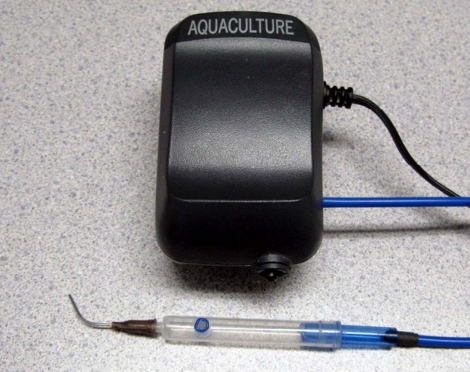[Ken] found that using traditional tweezers is a good way to lose tiny surface mount parts and so set out to make his own vacuum tweezers (PDF). He already had a small aquarium pump that he used as a bubbler for etching circuit boards. After opening up the case he found it was possible to connect tubing to the input of the pump to use as the source for the vacuum. The business end of the device is a syringe which he already had for applying oil in tight spaces. A file took off the sharp tip, and a small hole lined with a bit of soft tubing serves as a valve. Put the needle tip in place and plug the hole with your finger to pick it up. Works like a charm and will go well with our next feature, building your own reflow skillet.
We like [Ken’s] work. We just looked in on his copper clad enclosures yesterday.

















Simplisticly perfect and cheap!
Great job!
Oh wow, this is clever. Aquarium pumps are pretty useful in DIY/hacking, especially in making tools. I’ve seen them before in a modification to a desoldering iron to make them automatic or something like that.
Ken, That is a great design! Unfortunately I was a Manufacturing Engineer back in the leaded component days(I left just as SMDs were being introduced) I now repair Mac computers and have had a need for this kind of thing for a while. I’m going to build one soon. Thanks!
I think you’d want some kind of filter, so that you don’t damage the piston/diaphragm of the pump by sucking in nasty bits. Not sure how sensitive they are, but I know that the nicer pumps can get to be pretty expensive.
My god, this is exactly what I need
Could jam some of a cotton ball into the barrel for some filtration.
But why!?
I really don’t get it. I’ve seen ads in Nuts & Volts for vacuum “pick and place” devices, but still don’t see the point.
I’ve built so many SMD boards at work, using nothing but tweezers and a standard Weller soldering iron/tip.
I’ve tried things like this, and to me, it really just adds more work and makes it harder to build the things.
SMD isn’t hard guys…. (and I’m 50, and can’t see so well any more too, so…. I DO need magnification, but come on!)
LOL I was kind of thinking the same thing.
I’m doing QC on industrial gear (drives, PLCs, etc) and there are a couple of tricks I was shown when introduced to SMD for performing quality work on the fly.
I was told that when I learned SMD I wouldn’t want to do through-hole anymore and you know, I think they might be right.
Seems like the biggest hurdle is understanding the properties of molten solder, but I oversimplify and digress…
@George Johnson
(At 44 I also need magnification, so don’t sweat it, pops. ;) )
I’m with george on this one
I don’t see the need for the electric pump?
You can but a cheap “vacuum pick up tool” from China for about £1 which is basically a mechanical vacuum. Pull the plunger and it will lock onto the component.
I was given one at work once, but never found a use for it. As George says, it’s not needed.
I don’t even use tweezers for SMT usually. Place as close as possible by hand and move the component into place using the length of solder that’s in the opposite hand to my iron.
@george: For me, bad hands. 30 years of banging away at a keyboard almost daily, carpal tunnel, and a bit of a tremor. Tweezers work but this is much easier, you don’t have to worry about getting a grip on two sides.
If you’re having problems with tweezers, you’re probably using the wrong ones – you need to get the most pointy tweezers you can find. Using drug store tweezers is painful.
Check also negative tweezers.
http://ak.buy.com/PI/0/500/213586667.jpg
Sometimes tremors are due to both fingers pushing the tweezers to keep them closed.
I came here to post that SMD isn’t really that hard, and that I prefer it to through-hole mounting, and that you should get yourselves a pair of the pointiest tweezers on Digikey… only to find that no less then 3 other people had posted the same thing!
Give me SMD components, some liquid flux, a nice pointy soldering iron, and some pointy tweezers, and I’m in board-stuffing heaven :)
SMD and SMT are not the same thing…
One’s a lot smaller…
@draeth
One’s Surface Mount Device and the other Surface Moount Technology. The terms are largely interchangeable. And neither has any specific size associated with it.
Also read http://garage-shoppe.com/wordpress/?p=109 and http://garage-shoppe.com/wordpress/?p=164 to see an another build.